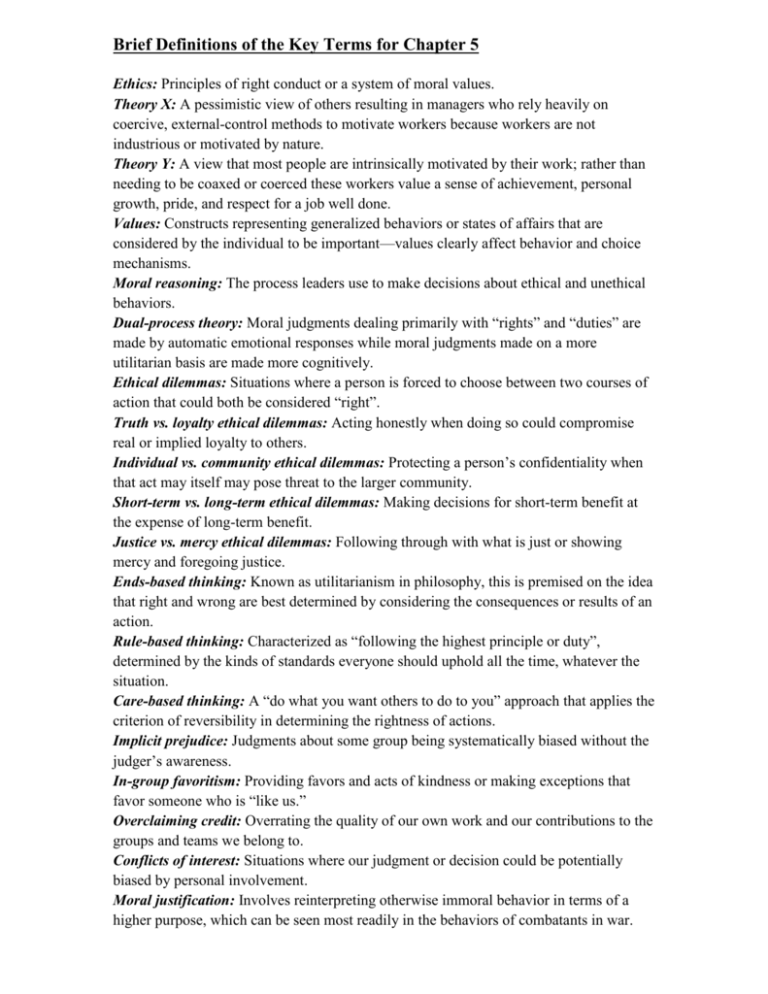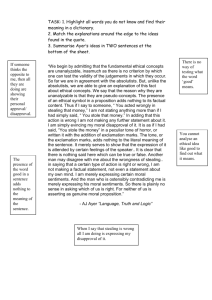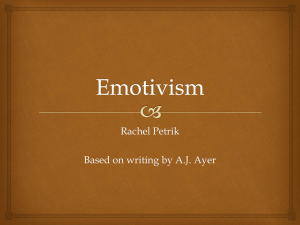File
advertisement

Brief Definitions of the Key Terms for Chapter 5 Ethics: Principles of right conduct or a system of moral values. Theory X: A pessimistic view of others resulting in managers who rely heavily on coercive, external-control methods to motivate workers because workers are not industrious or motivated by nature. Theory Y: A view that most people are intrinsically motivated by their work; rather than needing to be coaxed or coerced these workers value a sense of achievement, personal growth, pride, and respect for a job well done. Values: Constructs representing generalized behaviors or states of affairs that are considered by the individual to be important—values clearly affect behavior and choice mechanisms. Moral reasoning: The process leaders use to make decisions about ethical and unethical behaviors. Dual-process theory: Moral judgments dealing primarily with “rights” and “duties” are made by automatic emotional responses while moral judgments made on a more utilitarian basis are made more cognitively. Ethical dilemmas: Situations where a person is forced to choose between two courses of action that could both be considered “right”. Truth vs. loyalty ethical dilemmas: Acting honestly when doing so could compromise real or implied loyalty to others. Individual vs. community ethical dilemmas: Protecting a person’s confidentiality when that act may itself may pose threat to the larger community. Short-term vs. long-term ethical dilemmas: Making decisions for short-term benefit at the expense of long-term benefit. Justice vs. mercy ethical dilemmas: Following through with what is just or showing mercy and foregoing justice. Ends-based thinking: Known as utilitarianism in philosophy, this is premised on the idea that right and wrong are best determined by considering the consequences or results of an action. Rule-based thinking: Characterized as “following the highest principle or duty”, determined by the kinds of standards everyone should uphold all the time, whatever the situation. Care-based thinking: A “do what you want others to do to you” approach that applies the criterion of reversibility in determining the rightness of actions. Implicit prejudice: Judgments about some group being systematically biased without the judger’s awareness. In-group favoritism: Providing favors and acts of kindness or making exceptions that favor someone who is “like us.” Overclaiming credit: Overrating the quality of our own work and our contributions to the groups and teams we belong to. Conflicts of interest: Situations where our judgment or decision could be potentially biased by personal involvement. Moral justification: Involves reinterpreting otherwise immoral behavior in terms of a higher purpose, which can be seen most readily in the behaviors of combatants in war. Euphemistic labeling: Dissociating behaviors from one’s espoused moral principles by using “cosmetic” words to defuse or disguise the offensiveness of otherwise morally repugnant or distasteful behavior. Advantageous comparison: Allows one to avoid self-contempt for behavior by comparing it to an even more heinous behavior by others. Displacement of responsibility: People are able to violate personal moral standards by attributing responsibility to others (i.e., people who are merely carrying out orders). Diffusion of responsibility: Morally reprehensible behavior is easier to engage in and live with because others are behaving in the same manner. Distortion of consequences: A mechanism whereby people minimize the harm caused by their behavior—this can be a significant problem when people are insulated from the consequences of the decisions they make. Dehumanization: Another way of avoiding moral consequences for our actions that allows an individual to treat others badly when they are assigned epithets that make them less than human. Attribution of blame: An attempt to justify immoral behavior by claiming that it was caused by someone else’s behavior and not their own. Moral potency: The idea that moral courage, moral efficacy, and moral ownership affect ethical decision making. Moral ownership: A felt sense of responsibility not only for the ethical nature of one’s own behavior but also for one’s commitment not to allow unethical things to happen within their broader sphere of influence including others and the organization. Moral courage: The fortitude to face risk and overcome fears associated with taking ethical action. Moral efficacy: Belief or confidence in one’s capability to mobilize various personal, interpersonal, and other external resources to persist despite moral adversity. Moral person: A principled decision maker who cares about people and the broader society Moral manager: A manager who strives to “make ethics an explicit part of their leadership agenda by communicating an ethics and values message, by visibly and intentionally role modeling ethical behavior.” Authentic leadership: Leadership that is characterized by exhibiting a consistency between values, beliefs, and actions. Servant leadership: Leadership that stems in part from the teachings of Jesus that says that servanthood is the essence of worthy leadership. Upward ethical leadership: “Leadership behavior enacted by individuals who take action to maintain ethical standards in the face of questionable moral behaviors by higher-ups.” Ethical climate: A climate in which ethical standards and norms have been consistently, clearly, and pervasively communicated throughout the organization and embraced and enforced by organizational leaders in both word and example. Unethical climate: A climate in which questionable or outright unethical behavior exists with little action taken to correct such behavior, or (worse) where such misbehavior is even condoned. Principle-centered leadership: An approach that postulates a fundamental interdependence between personal, interpersonal, managerial, and organizational levels of leadership.








